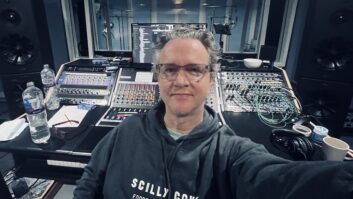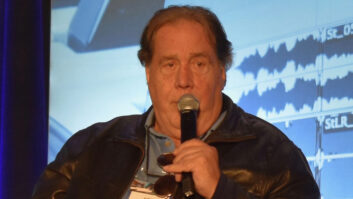For many touring artists, making the switch to an in-ear monitoring system or in-ears alone — rather than relying on wedges — can be daunting. Fears such as hearing damage, costs and not hearing oneself enough have shadowed an open discussion between bandmembers and their sound engineers on taking the leap to using in-ears. Mix’s sound reinforcement editor Mark Frink (k.d. lang’s longtime monitor engineer) offers advice on making the switch and the proper use of in-ears. And for those in the market, we offer a chart on currently available in-ear products.—Eds.
In-ear monitors replace a wedge-based system’s speakers and amplifiers with a small rack of electronics. Benefits include improved, consistent sound quality for the performers and the audience, decreased vocal and hearing fatigue, the ability to comfortably perform more shows and, for many, possibly extending a vocalist’s career by years. Side benefits include improved communication among the band, a reduced need for soundchecks and a ready-made, low-volume rehearsal rig.
Many bands starting out don’t have the funds to do it right and are looking for shortcuts. Placing a transducer in the ear can be dangerous and is not to be taken lightly. With careful planning, even those on a budget can enjoy good results, but the greatest returns require a significant investment and a competent operator to at least get it going, if not to mix every night. The first step is to get an audiologist to establish a baseline with a hearing test.
Drummers take to in-ears the best, as do many keyboard players. Singers and horn players love the isolation it provides from stage wash. Guitar players have the hardest time because they’re used to having a sweet spot that they can step into and it’s a whole new way of listening. Patience and careful planning are needed.The first step is to have an open, frank discussion between all bandmembers about cost and benefits, and it’s up to the sound engineer to be the ambassador for this new technology.
Short of having a dedicated monitor engineer to mix IEMs, there are a few shortcuts. Take the front-of-house mix and add a little “more me” for each performer using subgroups and matrix outs. A console with individual pre/post selection offers the most flexibility. This works the best when you have your own full-featured FOH desk; trying this approach with a different desk du jour on each tour stop can be painful and time-consuming.
Also, put a dedicated console onstage and make one bandmember make all adjustments. This onstage console needs to get a split of all critical inputs. Not all drum channels may be needed, but on most rackmount mixers, once you add all of the vocals and other instruments to kick, snare and hat, you’ve only got a few channels remaining for reverb and talkback.
Another engineer-less method is to use personal mixing stations. Early versions were made from multiple splits of individual inputs or subgroups (“stems”) of signals going to individual miniature mixers onstage, a concept borrowed from Broadway pit bands and cue systems in recording studios. These often still rely on a technician to supervise and set up the system and a dedicated console.
TWO TIMES TWO
The really cheap way to make the switch is by using consumer dynamic ear buds (much less than $100), which are often included with less-expensive systems, sometimes with ineffective, generic mold-like fittings that don’t provide isolation and, in the presence of any stage wash, have to be turned up. This can cause eventual hearing damage.
There are two types of pro IEMs: the generic or “universal-fit” style and custom ear molds made from an impression of the user’s ear that fit snugly and comfortably seal out ambient sounds. These use either dynamic drivers or balanced armature transducers (sometimes incorrectly called ribbon drivers). High-end molds often employ dual drivers to provide a fuller response.
The universal-fit transducers are less expensive and don’t require a custom fitting, though custom-molded tips can be made. These rely on either replaceable foam tips or silicone to seal them into the ear. Those with small ear canals will have trouble with some models. They’re also more annoying to put in and take out, and less comfortable than custom molds.
Experienced users are getting custom molds for the entire band. They cost more, but it is worth it in the long run. As a pro monitor engineer, I have sets by Firehouse, Future Sonics, Sensaphonics and Ultimate Ears that still work fine after many years. It’s important that the engineer and the performers all have the same model so that everyone has an even basis for comparison.
Before putting IEMs in the band’s ears, monitor engineers should try them on themselves. Bring molds, buds or even headphones to gigs and practice on a spare aux bus to get a feel for what individual inputs sound like and then practice building a mix. A good pair of closed headphones on a long cable onto the stage during soundcheck can let musicians try it before they’ve spent any money.
Warning: Everyone tries the “one in/one out” approach at some point. This leads to monitoring at higher levels and is more likely to lead to hearing fatigue and, eventually, hearing damage. Use both ears.
MAKE ME TWO WITH EVERYTHING
A professional IEM engineer provides much more than the usual wedge-based engineer, which is why they often earn as much as the FOH engineer — they’re worth it. Instead of creating a set-it-and-forget-it wedge mix with mostly “me” inputs, an IEM engineer will essentially make a full-on mix; bumps for solos and rides for dynamics are desirable over a static mix. Bands must allow time for the engineer to build the mix, especially while breaking in a new console.
Make sure you have a “European soundcheck” song, which starts with a beat on kick and snare and slowly adds one player at a time, giving monitor and FOH mixers time to get a sound. Carrying your own console is the only way to avoid this daily chore.
With stereo IEM mixes, panning makes it easier to hear each input and allows listening at lower levels. Panning a centered input to one side in a mix can make a bigger difference than a 6dB fader move.
All things being equal, a hardwired mix always sounds better, but money saved by not going wireless is often spent on thumpers or shakers, especially for drummers and bass players who want the frequencies below 100 Hz that are missed in most IEM transducers. Driven off a separate aux send, these need an amp and sometimes a crossover or a little EQ, and are either attached to the drum stool or, for standing players, mounted to a metal floor plate. An alternative is putting a subwoofer beside the player; sometimes just using the woofers in the sidefills or drum mix can work for this.
Outboard gear for IEMs comprises compressors, gates, reverbs and EQ, and is more like a remote broadcast than mixing monitors. Dynamic range must be carefully managed and being isolated from the room means that everything is carefully placed in the mix, including effects and ambient mics. A natural hall reverb makes vocals sound better and easier to hear; drums also benefit from a second separate reverb. Guitars and keys are often wet enough, but horns and background singers often need their dedicated reverbs. Inserting a reverb on the entire mix is not a recipe for success. A smaller band can make do with a single unit that is split “dual mono,” with one side for vocals and the other for drums.
EQ AND COMPRESSION
Sound companies, house rigs and festivals often have a rack of graphics available to insert on each monitor mix and some monitor consoles have output EQ, as well. Choose only four frequencies to fix so that, on days when you’ve got 4-band parametric output EQ instead of graphs, you can still get where you want to go.
Most IEMs start rolling off at 100 Hz; boosting here helps any mix sound better at lower levels. Most rooms and stages have too much 400 Hz (it leaks into the mics) and cutting it helps moderate-level mixes sound better. Three kHz is where many IEMs are strongest; a small cut can reduce harshness. Most IEMs start rolling off at 10 kHz, which is compounded by the fact that the response of wireless systems tends to falls off here. This is why many systems have an HF boost control. Alternatively, cutting 5 kHz can make 10 kHz stand out.
With many inputs going into each mix, it’s important to manage dynamics, especially with wireless, as they quickly start sounding bad when their meters hit the red. Turn up the master for quiet songs and then turn down again for the loud ones. Use a compressor across the mix. Early brickwall limiters were heralded as an important safety feature to prevent hearing damage, but performers are more likely to hurt themselves just by turning up the belt pack too loud.
Individual channel compression is more useful when used in the same manner as limiters, with higher thresholds and higher compression ratios to keep each input from pushing the entire mix into the red. To manage dynamics and tone when going from loud to soft, use a multiband compressor on the mix bus. Rather than simple compression or EQ, multiband compression can be used to increase subjective loudness while reducing hearing fatigue.
MICS AND ACCESSORIES
If you’re not carrying your own console, carrying your own mics is necessary for consistency. Re-creating a custom stereo mix for each performer is hard enough without introducing a different set of mics every night.
Guitarists are the hardest bandmembers to please. Even a stereo mic pair won’t give the sound enough dimension to be real and you get comb-filtering. Try using a Red Box DI: a post-amplifier direct box with EQ that mimics the speaker’s response and provides tube warmth and the effect pedals. Pan the mic to one side and the Red Box to the other to create a stereo sound with dimension. Alternatively, mike the back of an open-back combo amp and invert the polarity. Pan them wide, and the sound goes through the brain.
In the end, IEM engineers are usually RF engineers. Trips to major cities can be the RF highway to hell. And what successful entertainer won’t play there eventually? Have all of your wireless tricks on hand: good co-ax cable, directional antennas, combiners and a scanner.
Mark Frink is Mix’s sound reinforcement editor.
Link to Document
Click here to view a full chart of earpieces and hardware currently offered on the market.







